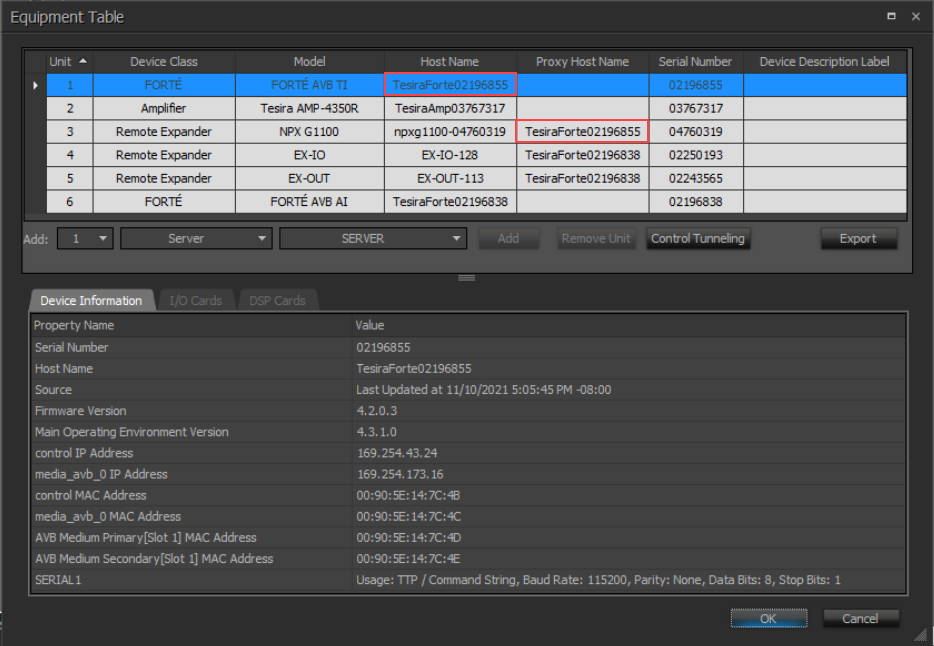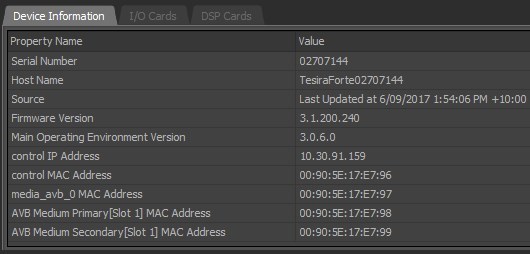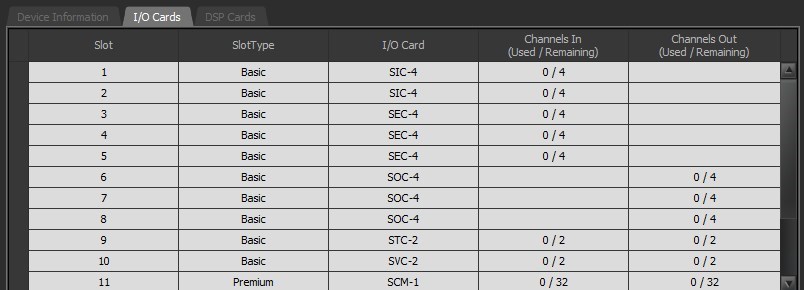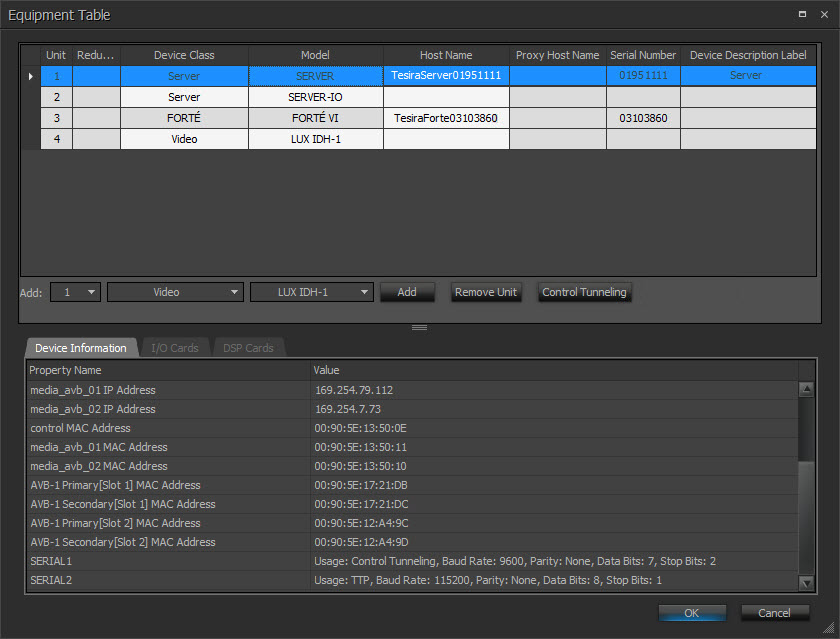Equipment Table
The Equipment Table correlates specific Tesira® hardware components to the system design. Compiling a system layout will populate the Equipment Table with the most efficient hardware solution for that system. The specific pieces of hardware (by serial number or hostname) can then be chosen for each component part. This must be done before a configuration can be sent to any Tesira device(s). The option to export a copy of the devices and their details contained in the Equipment Table is available via the File menu > Export function.
Equipment Table Modes
The Equipment table will display different options depending on the software mode being used.
-
TesiraFORTÉ mode - TesiraFORTÉ devices are added to the equipment table automatically when TesiraFORTÉ IO channels are specified in the layout. This is done by adding TesiraFORTÉ IO channels via the TesiraFORTÉ IO Component objects. Expander devices can be specified and the following devices are available - EX-MOD, EX-AEC, EX-IN, EX-OUT, EX-IO, Lab.gruppen Amplifier Tesira Amplifiers, Tesira Video ( IDH-1 & OH-1), NPX* and EX-LOGIC devices.
-
Tesira SERVER mode and Both TesiraFORTÉ and SERVER Mode - Allows addition of SERVER and SERVER IO devices. I/O Channels placed in the layout have an equipment filter to instruct the compiler to use certain hardware. TesiraFORTÉ devices are added to the equipment table automatically when TesiraFORTÉ IO channels are specified in the layout. This is done by adding TesiraFORTÉ IO channels via the TesiraFORTÉ IO Component objects. Expander devices can be specified.
- Add - Allows a Server, Server IO, Remote expander, Rack Mount Expander, Lab.gruppen Amplifier, Tesira Amplifiers, Logic Box, Tesira Video, TesiraFORTÉ and TC-5D device to be specified. Multiple devices can be added at once by setting the number of Add: devices and Device type.
- Remove Unit - will remove the selected device.
- Control Tunneling - shows serial port settings for server-class devices in the Device Information tab. See Control Tunneling for detailed information.
* When multiple servers are available to proxy an NPX device, the NPX must be assigned to the unit that holds the Paging and Zone Control Block. Failing to do so will cause the device to report that there are no page codes available.
The following example shows the Paging and Zone Control Block and the NPX Paging Station with the correct server class device as its proxy:

Assigning Host names to Units
Once a design file is programmed and compiled with valid I/O blocks present these will be assigned a unit number. When physical hardware is available, the unit number can be mapped to a physical piece of hardware by using the Host name drop down to discover devices and select them into the Equipment Table.
Click on the Host Name field in the line for a given device. Select the appropriate hostname from the available units online of that type.
| Note |
|
In order for a unit to be available for assignment, it must not be part of another system, i.e., Device ID and System ID must be 0 as seen in the Device Maintenance dialog. This can be achieved by Resetting the unit from within Device Maintenance. Resetting the device clears any configuration files stored on it. |
The Host Name field selects the TesiraFORTÉ, Server, Server IO that will become the ‘proxy’ for a given remote expander or rackmount expander unit. The chosen server is then responsible for firmware and configuration updates as well of real time control of the expander. To choose the proxy host name, click in the field on the entry for any expander unit after devices have been added to the system.

To manually add a unit, select the number of devices (of the same type) to be added by using the drop down field next to the Add: text. Use the next drop down to select the device class and finally the next dropdown to select the device type. Click the Add button. This will add as many devices as requested to the equipment list. After this the Host Name and Proxy Host Name (if expander unit) can be chosen for each device. To manually remove a unit, highlight the unit in the list and click on the Remove Unit button.
Viewing Unit Configuration
A Device Information tab at the lower of the Equipment Table dialog provides details of the assigned and selected device. If no device has been assigned yet this information will be blank. Once a device has been populated in the Equipment Table the information shown on the Device Information tab will be that of the last known state. This information is available even when the configuration is viewed offline.

An I/O Cards button provides a list of the input/output cards of a selected Tesira SERVER, SERVER IO, Lab.gruppen amplifier, Tesira Amplifier or EX-MOD rackmount expander. Click to show the I/O configuration of a given unit. The I/O Tab will not be displayed when Remote Expanders (EX-OUT, EX-IO, EX-IN, EX-AEC), Control (EX-LOGIC) or TesiraLUX devices are selected.

A DSP Cards tab shows the internal DSP hardware (and thus DSP resources available) contained in a selected Tesira SERVER, SERVER IO or TesiraFORTÉ unit. The DSP Cards Tab will not be displayed when Remote Expanders (EX-OUT, EX-IO, EX-IN, EX-AEC), Rack Mount Expander (EX-MOD), Control (EX-LOGIC) or TesiraLUX devices are selected.

When Connected to the system, the Equipment table can be viewed but not edited. The Device Information, I/O and DSP configurations of any SERVER, SERVER IO or TesiraFORTÉ can be viewed while connected.
Equipment Table entries can be exported via the File > Export > Export Equipment Table Entries. Refer to the File Menu section for more details.
